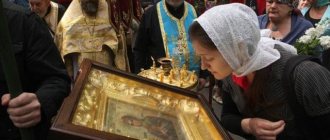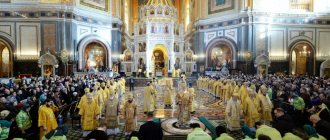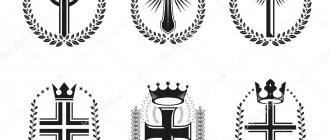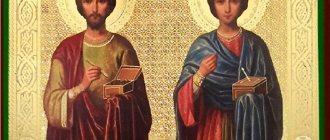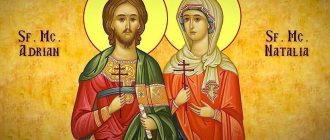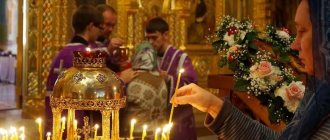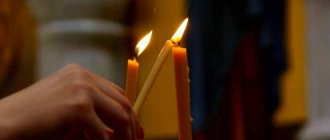People noticed that the remains of deceased saints remain incorruptible. This is a manifestation of God's will and a sign of His special favor. Therefore, they began to preserve the remains so that people could venerate them with faith for consolation and prayer.
In Christianity, the remains of saints are called relics and are revered as shrines
Among Christians there were and are people who lead righteous, holy lives. Such people in Christianity began to be called saints.
The Lord, through the prayers of the saints, helps people, even after their death. The saints constantly pray for us before the Throne of God.
Why do Orthodox Christians venerate the relics of God's saints?
The tradition of venerating the relics of holy saints is based on the miracle of the Incarnation. The Christian Church believes that Jesus Christ was resurrected not only spiritually, but also physically, therefore the physical shell of a person has no less value than the soul. People who achieved unity with the Lord during their lifetime became the receptacle of His Grace, which they poured out into the world around them. This ability is possessed not only by a living body, but also by the remains of a holy person.
Holy relics are the greatest shrines of the Orthodox Church
The veneration of holy relics was officially established at the Second Ecumenical Council. At the same time, the priests emphasized the importance of understanding the fact that worship is performed neither to the remains nor to the person, but to the Divine Power contained in them.
The cult of veneration of relics developed by the 8th century. through the efforts of the Church Fathers
The veneration of relics was approved by the Seventh Ecumenical Council in 787.
The cult of veneration of relics was developed in the works of the Church Fathers.
Basil the Great wrote: “Whoever touches the bones of a martyr receives some message of sanctification through the grace that dwells in the body of the martyr.”
John Chrysostom wrote:
“... just as the imperial crown, decorated on all sides with precious stones, gives off a varied shine, so the bodies of the holy martyrs, speckled as if with precious stones, with wounds raised for the Lord, are more precious and more venerable than any imperial crown.”
And further:
“...the sight of one garment of the dead or one word reproduced in thought often encourages the soul and revives the weakening memory. That’s why God gave us the remains of the saints!”
The analysis of the Bible on the subject of veneration of relics was carried out in the 8th century.
John of Damascus John of Damascus, in “An Accurate Exposition of the Orthodox Faith,” devoted an entire chapter to an analysis of the veneration of relics. He writes about the saints: “These have become the inner dwellings of God and His pure abiding places, for, says God, I will dwell in them and walk around, and I will be their God.”
He goes on to explain the meaning of the phrase from Numbers:
“According to the law, anyone who touched a dead thing was called unclean, but these are not dead. For after He who is life itself, the Author of life, has been counted among the dead, we do not call those who have fallen asleep in the hope of the resurrection and with faith in Him dead. For how can a dead body work miracles?”
And further:
“The Lord Christ gave us the relics of the saints as saving springs, which exude many different benefits and pour out fragrant myrrh... Through the relics of the saints, demons are cast out, diseases are repelled, the weak are healed, the blind receive their sight, lepers are cleansed, temptations and sorrows cease, and every good gift from the Father of lights descends on those who ask with undoubted faith"
Ephraim the Syrian writes in “A Word to All Martyrs”:
“The dead act as if they were alive, heal the sick, cast out demons, and by the power of Christ remove all obscene power, for in the holy remains there is always the grace of the Holy Spirit, performing all miracles in them.”
As a result, the dogma on the veneration of relics was adopted at the VIII Ecumenical Council in Nicaea, along with the dogma on the veneration of icons.
The meaning of the application to holy relics
A person who goes to venerate holy relics must understand that he is not worshiping the remains of a holy person, but God’s Grace. As during prayer in front of the icon, so during application to the relics of the holy primates, a person turns to their spirit, which is located at the Heavenly Throne. Holy people who have known His Grace during their lifetime are conductors of human prayers and the Will of the Lord.
Before the holy relics, people pray for the following:
- about the granting of physical and mental health,
- about strengthening the spirit and faith,
- about gaining strength to overcome the trials and difficulties of life,
- about help in family conflicts.
Worship of honorable holy remains can be performed not only for the purpose of asking for help and intercession, but also to express respect for a person who has accomplished a spiritual feat and received the special mercy of the Savior.
The origins of the tradition of venerating holy relics are found in the Bible
To find the roots of the cult of veneration of relics, let us turn to the Bible.
There is a duality in the Old Testament. On the one hand, he has a negative attitude towards the remains of dead bodies:
(Num. 19:11)
Whoever touches the dead body of any person will be unclean for seven days.
However, at the same time, the Old Testament describes the case of the resurrection of a person through touching the remains of a righteous man:
(2 Kings 13:21)
And it came to pass that when they were burying one man, when they saw this horde, those who were burying them threw that man into the tomb of Elisha; and when he fell, he touched the bones of Elisha, and came to life, and rose to his feet.
The New Testament mentions healing with things taken from the dead:
(Acts 19:12)
So they put handkerchiefs and aprons from his body on the sick, and their illnesses stopped, and evil spirits came out of them.
The Apostle Paul points to the presence of God in every person:
(1 Cor. 6:19)
Do you not know that your body is a temple of the Holy Spirit who dwells in you, which you have from God, and you are not your own?
The apocryphal Book of Solomon says:
(Wis. 3:1)
But the souls of the righteous are in the hand of God, and torment will not touch them.
Apocrypha - a church book not recognized by the official church
Further, the teaching about the veneration of relics passed from Holy Scripture to Holy Tradition.
Holy relics and church etiquette
The presence of holy relics in any locality is an important event in the spiritual life of this region. A long line of Christians line up at the shrine, wanting to partake of Divine grace. Large crowds of people require that every believer observe church etiquette and special recommendations of the Orthodox Church for pilgrims.
Holy relics help Christians strengthen their faith and experience God’s grace
When visiting any Orthodox religious organization, the following rules should be observed:
- The pilgrim's clothing must comply with pious Christian traditions. Women should wear long-hemmed clothing that covers their shoulders. The presence of a headdress for ladies is a mandatory requirement. Men should choose items that cover their knees and shoulders.
- You cannot approach the shrine while under the influence of alcohol or drugs.
- While in church, you should maintain silence, do not jostle or argue with other parishioners.
Many people come to venerate the relics. The clergy consider standing in line at the shrine a spiritual test for the pilgrim. This time can be spent doing the following:
- reading the life and akathist to the saint,
- a prayer appeal to the primate, which sets out a request,
- writing notes for a prayer service read by priests at the relics.
When planning to venerate the relics, you should take into account weather conditions and your own state of health. If necessary, you should take the following items with you:
- an umbrella that protects from both the sun and precipitation,
- folding chair,
- medicines,
- water in a plastic container.
Pilgrims who take children for attachment should take into account that they cannot concentrate on monotonous activities for a long time. Parents should consider what to do with their children while they wait. The child should be prepared for visiting the temple and applying to the relics as follows:
- talk about the life of the holy man whose relics they decided to venerate,
- explain the meaning of the action taking place,
- talk about the structure of the temple, the role of priests in the spiritual life of a person.
Icon with a particle of the relics of St. Luke of Crimea, wonderworker
During your stay in the temple, you should answer the child’s questions in a quiet voice. A pilgrimage to the shrine should leave good and bright feelings in his soul.
Questions encountered in parish counseling practice and answers to them
1
. Bible. Books of the Holy Scriptures of the Old and New Testaments. M.: Russian Bible Society. 2002. – 1376 p.
2
. God's Law. Compiled by Archpriest Seraphim Slobodskoy. St. Petersburg Brotherhood of the New Martyr Archbishop Hilarion of Vereisky, 2000. – 724 p.
3
. The Law of God, compiled according to the Holy Scriptures and the sayings of the Holy Fathers, as a practical guide to spiritual life. M.: Sretensky Monastery; A new book; Kovcheg, 2004. – 704 p.
4
. Explanatory Typikon. Explanatory presentation of the Typikon. Compiled by Professor of the Kyiv Theological Academy Mikhail Skaballanovich. M.: Publication of the Sretensky Monastery, 2004. – 816 p.
5
. Bulgakov S.V. Handbook for priests and church ministers. (Reprint of the 1913 edition). Publishing department of the Moscow Patriarchate, 1993. – 1772 p.
6
. Priest K. Subbotin. A guide to the study of the Charter of Divine Services of the Orthodox Church. Kyiv. Society of lovers of Orthodox literature. Publishing house named after St. Leo, Pope of Rome, 2007. – 360 p.
7
. Priest A. Kremlevsky. Fundamentals of Orthodox dogma. Holy Trinity Sergius Lavra, 2001. – 208 p.
8
. Explanations to the Sacraments of the Orthodox Church. St. Petersburg: Satis, 2003. – 128 p.
9
. Explanation of the Liturgy in questions and answers. M.: Blago, 2006. – 48 p.
10
. About Orthodoxy for beginners. Kyiv. Printing house of the Kiev-Pechersk Lavra, 2005. – 96 p.
11
. Basics of Orthodoxy. Holy Dormition Pochaev Lavra, 2001. – 96 p.
12
. The very first steps in the temple. Advice for a beginning Christian. M.: Publishing house of the sisterhood in the name of St. Ignatius Brianchaninov, 2006. – 224 p.
13
. First steps in an Orthodox church. M.: Publication of the Orthodox Brotherhood in the Name of the Exaltation of the Honest and Life-Giving Cross of the Lord, 1999. – 64 p.
14
. Priest M. Shpolyansky. We enter the temple. A practical guide on the way to church. Publishing house Obraz, M.: 2005. – 128 p.
15
. Shchegoleva E., Glagoleva O. In the Orthodox Church. – M.: OLMA Media Group; OLMA-PRESS, 2006. – 304 p.
16
. Deacon Alexy. Evgeny Sanin. Advice for those going to Church. M.: Orthodox Brotherhood of the Holy Apostle John the Theologian, 2000. – 62 p.
17
. What a Christian should know. Saratov. Saratov public charitable organization “Blagovestnik”, 1999. – 112 p.
18
. About “bread” and “water” in the life of the Church. M.: Publishing house of the Holy Trinity Sergius Lavra, M.: 1997. – 30 p.
19
. What you need to know about holy water. M.: Sretensky Monastery; New book, 1999. – 32 p.
20
. Kazakov O.A. About holy water and prosphora, about oil and incense. St. Petersburg: Satis, 2005. – 48 p.
21
. Instructions for the Orthodox layman about the church candle. – M.: Moscow courtyard of the Holy Trinity Sergius Lavra; New book, 1996. – 32 p.
22
. About the Sacrament of Baptism. M.: Blagovest, 2003. – 32 p.
23
. How to prepare for Communion. Minsk: JSC “Orthodox Initiative”, 2004. – 32 p.
24
. What you need to know about the Sacrament of Unction. / Prepared from the book of Archpriest Mikhail Arkhangelsky “On the Mystery of St. Oil. A study on the historical development of the rite of the Blessing of Anointing.” Edinet-Brichany Diocese. Kaluga, “Kaluga Standards Printing House”, 2004. – 64 p.
25
. The Sacrament of Anointing: - M.: Filaret Publishing House, 2005. - 56 p.
26
. How to correctly submit notes “On health” and “On repose”. M.: Sretensky Monastery; New book, 1999. – 32 p.
27
. S. Alekseev. How to arrange a home iconostasis. St. Petersburg: Satis; Power, 2003. – 32 p.
28
. How to pray correctly according to the teachings of the Holy Fathers. M.: Blago, 2002. – 32 p.
29
. How to accustom yourself to fasting. – M.: Sretensky Monastery; A new book; “Ark”, 1999. – 64 p.
30
. Why is it necessary to get married? Minsk: Orthodox Initiative, 2005. – 64 p.
31
. What name to choose for a newborn. M.: Blago, 2005. – 32 p.
32
. How to behave in a cemetery. Practical advice on behavior in the cemetery and commemoration of the dead. The rite of litia, performed by a layman at home and in the cemetery. Akathist about the repose of the dead. M.: Sretensky Monastery; New book, 1997. – 48 p.
33
. About the end of the world. The brochure is compiled according to the Pskov-Pechersk leaflets Nos. 204, 209 with additions from the correspondence of the elders of the monastery with their spiritual children. M.: Father's House, 2000. – 80 p.
34
. Archpriest Valentin Mordasov. Notebooks of an experienced confessor. Moldova. Edinet-Brichany diocese, 2006. – 160 p.
35
. What should we sinners do? M.: Publishing house Danilovsky Blagovestnik, 1994. – 80 p.
36
. Spiritual life begins with repentance. Hieromonk Sergius (Rybko). M.: Publishing house named after. St. Ignatius Brianchaninov, 2003. – 416 p.
37
. Archimandrite Ambrose Yurasov. About faith and salvation. Questions and answers. Ivanovo. Ivanovskaya newspaper, 1996. – 286 p.
38
. Answers to 1140 questions about spiritual life. M.: 1994. – 240 p.
39
. Soul healer. Holy Fathers - to the laity. M.: Publishing house of the sisterhood in the name of St. Ignatius of Stavropol, 2006. – 184 p.
40
. Sablina N.P. Words under titles. St. Petersburg: Izhitsa, 2001. – 44 p.
41
. Uspensky L.A. Theology of the icon of the Orthodox Church. Pereslavl: Publishing house of the brotherhood in the name of the holy prince Alexander Nevsky. 1997.– 656 p.
42
. One hundred fifty-three questions for the priest. Comp. O.A. Kazakov. St. Petersburg: Satis, 2006. – 64 p.
43
. ABOUT FEAR: True and false fear. M.: Danilovsky blagovestnik, 2007. – 320 p.
44
. Handbook of an Orthodox person: Orthodox Church. M.: Danilovsky Blagovestnik, 2007. Part I – 128 p.
45
. Archpriest Alexander Torik. CHURCHING: for beginners in church life. M.: Siberian Blagozvonnitsa, 2007. – 64 p.
46
. Book of Hours. Ukrainian Orthodox Church. Vinnitsa diocese, 2001. – 352 p.
47
. Saint Theophan the Recluse. Interpretation of psalms six psalms three and thirty-seven. M.: Publishing house named after. St. Ignatius Brianchaninov, 2002. – 64 p.
48
. Shimansky G.I. LITURGICS: Sacraments and rituals. M.: Publication of the Sretensky Monastery, 2003. – 352 p.
49
. Leaflet with an article by Yu. Ruban “Agiasma”. Cultural and educational at the Church of the Icon of the Mother of God “Joy of All Who Sorrow” on Shpalernaya Street.
50
. Archbishop Averky Taushev. Four Gospels. Apostle. A Guide to Studying the Holy Scriptures of the New Testament. M.: Orthodox St. Tikhon's Theological Institute, 2003. – 848 p.
51
. Missionary leaflets. Missionary department of the St. Petersburg diocese of the Russian Orthodox Church.
52
.
Priest Mikhail Trukhanov. About Scripture making wise for salvation ( about the meaning for an Orthodox Christian of reading the Holy Scriptures).
Kyiv: Publishing house named after. St. Leo the Great, 2000. – 32 p.
53
. About superstitions, prejudices and modern religious ignorance. M.: Blago Publishing House, 2002. – 112 p.
54
. V. Dukhanin. What do we believe? 100 answers to a contemporary. M.: Publishing Council of the Russian Orthodox Church, 2008. – 256 p.
55
. Bogolyubov D.I. Orthodox anti-sectarian catechism. St. Petersburg: Satis, 1994. – 112 p.
56
. Schema-abbot Savva. Spiritual ABC. M.: Orthodox Brotherhood of the Holy Apostle John the Theologian, 2004. – 78 p.
57
. Heal me, O God...: The Sacrament of Unction. Comp. G.N. Stromynsky. M.: Lepta Book, 2008. – 96 p.
58
. Priest Oleg Davydenkov. Catechism. Introduction to Dogmatic Theology. M.: Publishing house of the Orthodox St. Tikhon's Theological Institute, 2000. – 232 p.
59
. Archpriest Vladimir Goffman. The art of being a Christian. Answers to questions from parishioners. N. Novgorod: Publishing house of NP PC “Glagol”, 2007. – 192 p.
60
. Trostnikova E.V. Holidays of the Orthodox Church. M.: Eksmo, 2008. – 304 p.
61
. Hegumen Peter (Meshcherinov). Church and modernity. Questions and answers. K.: Orthodox Book Center, 2008. – 272 p.
62
.
Internet. Lectures by professor MDA Osipov A.I. In the preparation of educational and methodological manuals under the leadership of
the Chairman of the Department of Religious Education and Spiritual Enlightenment of the St. Petersburg Diocese, Archpriest Alexander Zelenenko
participated:
Deacon Konstantin Gorbunov, head of the parish advisory service of the Church of the Holy Prophet Elijah on Porokhov, St. Petersburg diocese
Krasnozhon O.V., Kuznetsova I.I., duty officers of the parish advisory service of the Church of the Savior of the Image Not Made by Hands in Pargolovo, St. Petersburg Diocese
Moiseeva A.G., employee of the Department of Religious Education and Spiritual Enlightenment of the St. Petersburg Diocese
Thank you for your help in preparing the second edition:
priest Grigory Antipenko, deacon Oleg Alekseev, Zavyalova S.Yu., Kontsevaya N.I., Pivovarova G.R., Andreenko G.A.
How to properly venerate the relics of saints
Believers should understand that many pilgrims want to touch the holy relics. In order not to prolong the wait for them, while at the shrine, you should adhere to the following sequence of actions:
- When approaching the shrine with the shrine, you should bow to the ground twice.
- After bowing you should cross yourself.
- After making the sign of the cross, the pilgrim venerates the relics. You should touch the exposed limbs or clothing of the relics.
- A pectoral cross or personal icon can be applied to the side surface of the shrine while being applied to the relics.
- After venerating the shrine, you must cross yourself again and move away without holding up the line.
Is it worth reading prayers in front of the relics?
The prayer request to the primate is not read directly near the shrine with the relics, as this delays the queue. They begin to read a prayer to a holy person at home or in line at the shrine. After application, the prayer is read at home in front of home images.
The Orthodox Church recognizes not only the body, but also the bones of a holy person as relics
This recommendation applies to a situation where the relics are temporarily in a locality. Pilgrims who come to venerate the relics in their place of permanent residence should follow the recommendations given by local clergy.
The relics are kept in the temple in specially equipped places
Holy relics are stored in different ways:
- In crayfish. Rak - a box with holy relics, usually made in the form of a coffin. Crayfish are installed in temples and monasteries.
Reliquary with the relics of St. Seraphim of Sarov
Reliquaries of especially revered saints are made of expensive materials and richly decorated.
If the reliquary is not opened for worship, then it is said to be kept “under cover.”
- In the arks. A small box for relics is called an ark. Reliquaries can have several compartments - then the relics of different saints can be placed in it.
A reliquary with the relics of St. Spyridon
They try to make reliquaries from expensive and reliable materials and richly decorate them.
The relics in the reliquary are placed under the altar of the temple during consecration. In this case, they read the prayer: “The Lord Himself, the Giver of good things, through the prayers of the saints, You have favored them with the position of their relics in this honorable altar of Thy existence, grant us the uncondemned bloodless sacrifice to Thee on it.”
- In reliquaries. Reliquary is a general name for anyone used to store relics. Usually, a reliquary is understood as a pectoral cross with particles of relics that protects the person wearing it.
A reliquary in the shape of a cross is called an encolpion.
Reliquaries are periodically found at excavations. At one time, the loss of a reliquary was a heavy loss for the owner
- In reliquaries. A reliquary is an exquisitely crafted and richly decorated reliquary, usually made in the shape of a church. Reliquaries became widespread in Catholic countries.
A unique reliquary in the form of a bust was made for the relics of Charlemagne
Where can you venerate the relics of saints?
On the territory of Russia there are many relics of holy people who shone in the Russian lands. The most revered shrines by Orthodox Christians are located in the following monasteries:
- the relics of Saint Matrona of Moscow rest in the Intercession Monastery of the Russian capital,
- the holy remains of Sergius of Radonezh are located in the monastery he founded in the town of Sergiev Posad near Moscow,
- the relics of Savva Storozhevsky rest in Zvenigorod,
- the relics of Seraphim of Sarov are located in the Diveyevo Monastery, located in the Nizhny Novgorod region,
- the relics of Alexander Nevsky are located in the Alexander Nevsky Lavra in St. Petersburg,
- The relics of Tikhon of Zadonsk rest in the Zadonsk Bogoroditsky Monastery.
A complete list of Russian shrines can be seen on the website of the Moscow Patriarchate.
A piece of the relics of various saints is necessarily kept in every Orthodox cathedral. Church tradition does not allow the consecration of a new temple if a part of some shrine is not present in it.
How do they treat relics in the Orthodox Church?
Many lay people believe that only the incorruptible remains of people recognized as holy men are called relics. But the Orthodox Church recognizes as relics not only the incorruptible body, but also the bones and ashes of a holy person.
Reliquary with the relics of Saint Matrona in the Church of the Intercession Monastery
The clergy note that the basis for the canonization of a righteous person is the spiritual deeds he performs during his life, and the miraculous deeds that occur through prayer to him after the end of his earthly journey.
Interesting: Athonite monks consider the incorruption of the body to be a sign of the presence of unrepentant sins in a deceased person. The monks, having discovered such remains, begin to pray intensely for the soul of their departed brother.
Is it possible to venerate relics during menstruation?
According to the established Christian church tradition, a woman during monthly ailments should not go into the church further than the vestibule. In some cases, with the blessing of the rector of the chosen temple, she can be in the main temple premises, but at the same time she is forbidden to hold a candle, venerate shrines and receive church sacraments.
Some modern priests note that a woman during menstruation can pray at the holy relics with the blessing of her confessor, but she should not touch the Shrine.
Holy relics, along with icons, crucifixes and material evidence of the life of Jesus Christ and the Mother of God, are the greatest shrines of the Christian Church. They help Christians strengthen their faith and experience God’s Grace, which lies in the remains of holy people.

